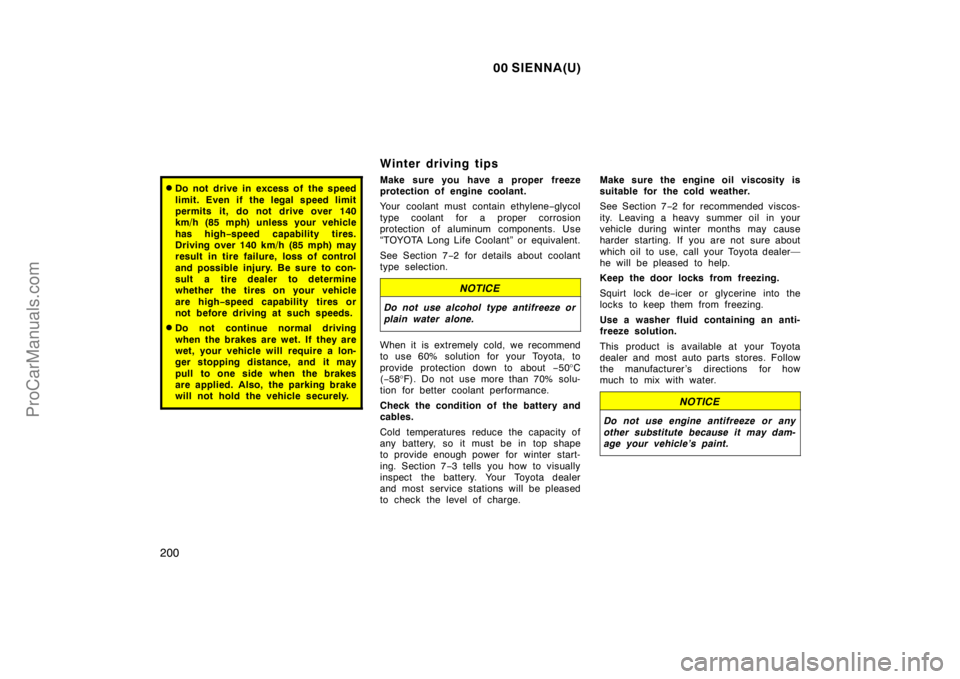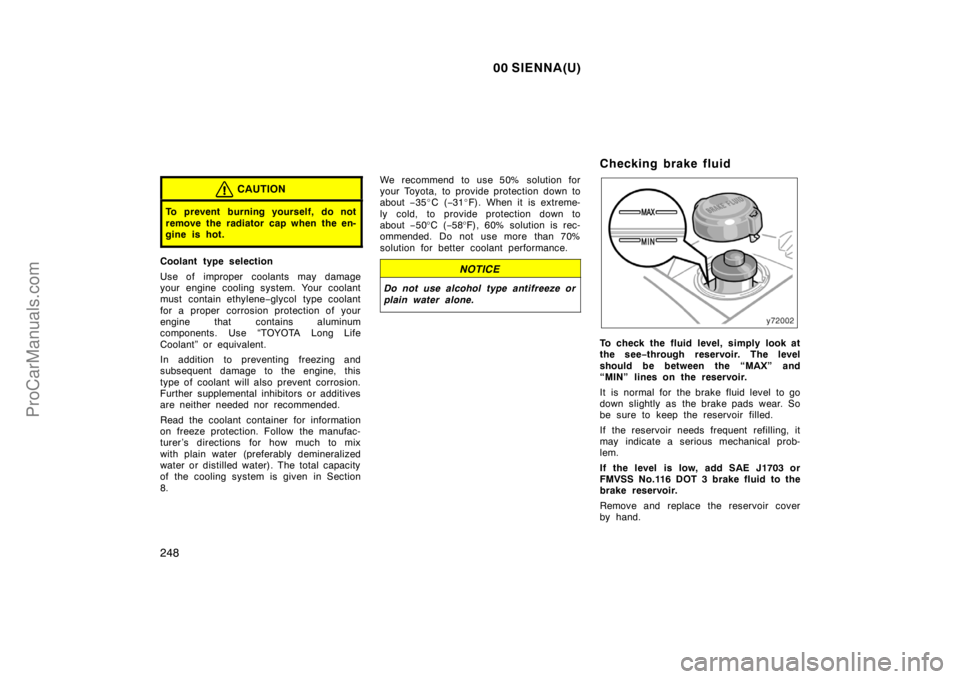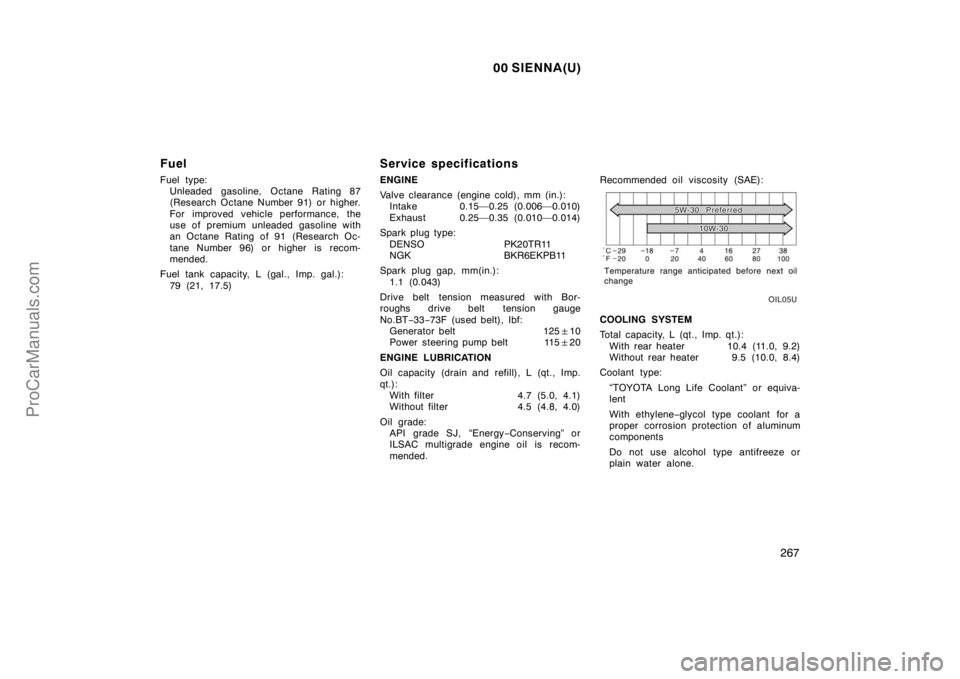Page 206 of 282

00 SIENNA(U)
200
�Do not drive in excess of the speed
limit. Even if the legal speed limit
permits it, do not drive over 140
km/h (85 mph) unless your vehicle
has high−speed capability tires.
Driving over 140 km/h (85 mph) may
result in tire failure, loss of control
and possible injury. Be sure to con-
sult a tire dealer to determine
whether the tires on your vehicle
are high−speed capability tires or
not before driving at such speeds.
�Do not continue normal driving
when the brakes are wet. If they are
wet, your vehicle will require a lon-
ger stopping distance, and it may
pull to one side when the brakes
are applied. Also, the parking brake
will not hold the vehicle securely.
Winter driving tips
Make sure you have a proper freeze
protection of engine coolant.
Your coolant must contain ethylene−glycol
type coolant for a proper corrosion
protection of aluminum components. Use
“TOYOTA Long Life Coolant” or equivalent.
See Section 7−2 for details about coolant
type selection.
NOTICE
Do not use alcohol type antifreeze or
plain water alone.
When it is extremely cold, we recommend
to use 60% solution for your Toyota, to
provide protection down to about −50°C
(−58°F). Do not use more than 70% solu-
tion for better coolant performance.
Check the condition of the battery and
cables.
Cold temperatures reduce the capacity of
any battery, so it must be in top shape
to provide enough power for winter start-
ing. Section 7−3 tells you how to visually
inspect the battery. Your Toyota dealer
and most service stations will be pleased
to check the level of charge.Make sure the engine oil viscosity is
suitable for the cold weather.
See Section 7−2 for recommended viscos-
ity. Leaving a heavy summer oil in your
vehicle during winter months may cause
harder starting. If you are not sure about
which oil to use, call your Toyota dealer—
he will be pleased to help.
Keep the door locks from freezing.
Squirt lock de−icer or glycerine into the
locks to keep them from freezing.
Use a washer fluid containing an anti-
freeze solution.
This product is available at your Toyota
dealer and most auto parts stores. Follow
the manufacturer ’s directions for how
much to mix with water.
NOTICE
Do not use engine antifreeze or any
other substitute because it may dam-
age your vehicle’s paint.
ProCarManuals.com
Page 254 of 282

00 SIENNA(U)
248
CAUTION
To prevent burning yourself, do not
remove the radiator cap when the en-
gine is hot.
Coolant type selection
Use of improper coolants may damage
your engine cooling system. Your coolant
must contain ethylene−glycol type coolant
for a proper corrosion protection of your
engine that contains aluminum
components. Use “TOYOTA Long Life
Coolant” or equivalent.
In addition to preventing freezing and
subsequent damage to the engine, this
type of coolant will also prevent corrosion.
Further supplemental inhibitors or additives
are neither needed nor recommended.
Read the coolant container for information
on freeze protection. Follow the manufac-
turer’s directions for how much to mix
with plain water (preferably demineralized
water or distilled water). The total capacity
of the cooling system is given in Section
8.We recommend to use 50% solution for
your Toyota, to provide protection down to
about −35�C (−31�F). When it is extreme-
ly cold, to provide protection down to
about −50°C (−58°F), 60% solution is rec-
ommended. Do not use more than 70%
solution for better coolant performance.NOTICE
Do not use alcohol type antifreeze or
plain water alone.
Checking brake fluid
To check the fluid level, simply look at
the see−through reservoir. The level
should be between the “MAX” and
“MIN” lines on the reservoir.
It is normal for the brake fluid level to go
down slightly as the brake pads wear. So
be sure to keep the reservoir filled.
If the reservoir needs frequent refilling, it
may indicate a serious mechanical prob-
lem.
If the level is low, add SAE J1703 or
FMVSS No.116 DOT 3 brake fluid to the
brake reservoir.
Remove and replace the reservoir cover
by hand.
ProCarManuals.com
Page 273 of 282

00 SIENNA(U)
267
Fuel
Fuel type:
Unleaded gasoline, Octane Rating 87
(Research Octane Number 91) or higher.
For improved vehicle performance, the
use of premium unleaded gasoline with
an Octane Rating of 91 (Research Oc-
tane Number 96) or higher is recom-
mended.
Fuel tank capacity, L (gal., Imp. gal.):
79 (21, 17.5)
Service specifications
ENGINE
Valve clearance (engine cold), mm (in.):
Intake 0.15—0.25 (0.006—0.010)
Exhaust 0.25—0.35 (0.010—0.014)
Spark plug type:
DENSO PK20TR11
NGK BKR6EKPB11
Spark plug gap, mm(in.):
1.1 (0.043)
Drive belt tension measured with Bor-
roughs drive belt tension gauge
No.BT−33−73F (used belt), Ibf:
Generator belt 125�10
Power steering pump belt 115�20
ENGINE LUBRICATION
Oil capacity (drain and refill), L (qt., Imp.
qt.):
With filter 4.7 (5.0, 4.1)
Without filter 4.5 (4.8, 4.0)
Oil grade:
API grade SJ, “Energy−Conserving” or
ILSAC multigrade engine oil is recom-
mended.Recommended oil viscosity (SAE):
COOLING SYSTEM
Total capacity, L (qt., Imp. qt.):
With rear heater 10.4 (11.0, 9.2)
Without rear heater 9.5 (10.0, 8.4)
Coolant type:
“TOYOTA Long Life Coolant” or equiva-
lent
With ethylene−glycol type coolant for a
proper corrosion protection of aluminum
components
Do not use alcohol type antifreeze or
plain water alone.
ProCarManuals.com